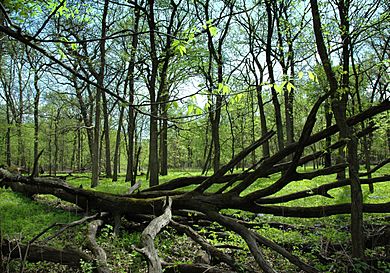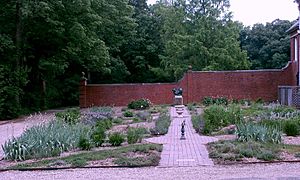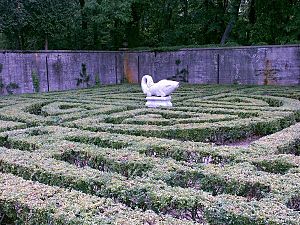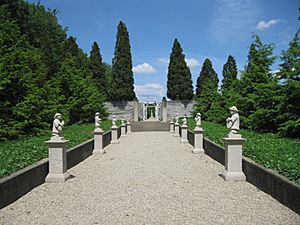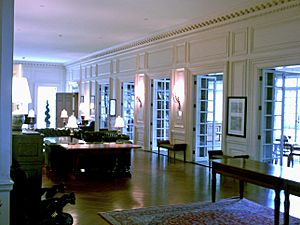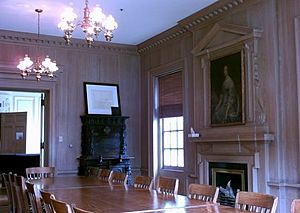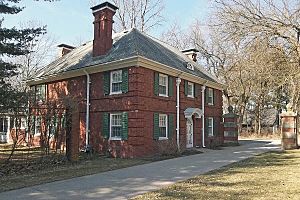Robert Allerton Park facts for kids
Quick facts for kids |
|
|
Allerton, Robert, Estate
|
|
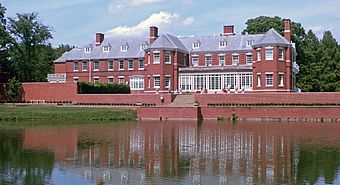
Allerton House and Reflecting Pond
|
|
| Lua error in Module:Location_map at line 420: attempt to index field 'wikibase' (a nil value). | |
| Location | 515 Old Timber Rd., Monticello, Illinois |
|---|---|
| Area | 800 acres (320 ha) |
| Built | 1900 |
| Architect | Borie, John Joseph; et al. |
| Architectural style | Colonial Revival |
| NRHP reference No. | 07000701 |
| Added to NRHP | July 18, 2007 |
The Robert Allerton Park is a huge 1,517-acre (614 ha) park, nature center, and conference center. It's located in the countryside of Piatt County, Illinois, near Monticello, Illinois, along the Sangamon River. The park and its main house, called The Farms, were created by Robert Allerton. He was an artist, art collector, and garden designer who inherited a lot of money. In 1946, Robert Allerton gave this amazing place to the University of Illinois at Urbana-Champaign.
The National Park Service officially recognized the Robert Allerton Estate as a National Register of Historic Places on July 18, 2007. Also, a special part of the park, the Allerton Natural Area, was named a National Natural Landmark in 1970.
Today, about 100,000 people visit the park each year. It's known as a "vast prairie turned into a personal fantasy land" with statues, art from Asia, and huge European-style gardens around a beautiful Georgian-Revival mansion.
Contents
About Robert Allerton
Robert Henry Allerton (1873–1964) inherited a large fortune from his father, Samuel Allerton. His father was one of the people who started Chicago's famous Union Stock Yards. Robert loved art from a young age. He studied art for four years in big cities like Munich, Paris, and London.
In 1897, he came back to Illinois and settled on one of his family's farms near Monticello. Two years later, he started building the impressive brick mansion. For the next 47 years, Robert Allerton turned The Farms into a stunning estate in central Illinois. The busiest time for creating new features was in the 1920s and early 1930s. In 1932, John Gregg (1899–1986) started working full-time for Allerton. John helped design new gardens and parts of the house. He later became Robert Allerton's adopted son in 1960.
Robert Allerton also had strong connections with the University of Illinois at Urbana-Champaign. In 1920, the University asked him to help plan their campus. He also started the Allerton Scholarships in American architecture in 1926. Each year, he invited architecture and landscape design students to visit The Farms.
Gift to the University of Illinois
After difficult times like the Great Depression and World War II, it became hard to keep up such a large estate. So, in 1946, the Allertons moved to Hawaii. They gave their Piatt County property to the University of Illinois.
When the University took over, there was a disagreement about taxes. The local township didn't want to lose the tax money from the estate. Eventually, the Illinois Supreme Court decided that the University would make a yearly payment to Piatt County instead of taxes. Today, the public park and woodlands are tax-free, but the farmland that earns money for the park is still taxed.
When Robert Allerton gave the estate to the University on October 14, 1946, it was worth about $1.3 million. That would be like nearly $14 million today!
The large estate was divided into three main parts:
- The main area of 1,500 acres was named the Robert Allerton Park.
- A smaller area to the north was used for the Illinois 4-H Memorial Camp.
- The largest part, about 3,775 acres of farmland, was rented out. The money earned from these farms helped support the rest of the park.
In 2007, the northern farms were given to the University's main investment fund. This means the park now gets a share of the money earned from those investments each year.
After the University took over in 1946, the park stayed closed to the public for a few years. It needed more staff and facilities. The first big event was a party in May 1947 to celebrate the new University president. The public got a peek at the park later that month, but it didn't fully open until 1949.
It took several years to get Allerton House ready as a conference center. The first conference was held there in June 1949. It was a seminar about educational radio with people from all over the world!
Robert Allerton was a generous person throughout his life. Today, both Robert Allerton Park in Illinois and Allerton Garden in Hawaii are open for everyone to enjoy. He also gave important gifts to the Honolulu Museum of Art and the Art Institute of Chicago.
Gardens
Allerton Park has beautiful gardens. There's a long formal garden about 1/4-mile long. From there, a sculpture walk stretches for 11⁄4 miles. The gardens are filled with many sculptures and decorations.
The gardens are designed along a line that follows the Sangamon River. This line runs from the northeast to the southwest through the park.
Fu Dog Garden
This garden has 22 blue porcelain Fu Dog statues. They stand in front of white fir trees. Robert Allerton had this garden built in 1932 to show off his collection of these ceramic statues. The fir trees form the garden's outer edge. To make sure the garden got enough sunlight, the surrounding woods were cut back. North of this garden is the House of the Golden Buddhas, which is a fun building that lets you see the garden from above.
Herb Garden
The Herb Garden, also called the Kitchen Garden, is located behind the stable. It's known for its many green herbs and a green porcelain Fu Dog statue. It was redesigned in 1997, and new plants were added in 1999. Over the years, a sundial, an urn, and a planter have been added.
Brick Walled Garden
This is the oldest garden at Allerton Estate, built in 1902. It has tall, red-brick walls. It was first a vegetable garden with bean supports and a small pool for watering plants. In the 1940s, the plants were changed to grassy areas with hedges. The pool was replaced by the Girl with the Scarf sculpture, a white concrete figure added in 1942.
The brick walls were repaired in 2010 because they were getting old. Many parts of the walls were rebuilt. Old stone fruit baskets and globe stones from 1905 were put back on the new walls. New paths were added, including a ramp for wheelchairs. New plants, flowers, and espaliered apple trees were also planted. In 2019, the gravel paths were changed to a harder surface to make them easier for wheelchairs.
Triangle Parterre Garden
This garden used to have tall arborvitae trees and annual flowers in triangular hedge patterns. In spring 2019, the garden was replanted with new arborvitae and boxwood hedges. This was done to make it look more like Robert Allerton's original design. At the ends of the garden are two stone animal sculptures called Assyrian Lions. A stair tower pavilion built in 1987 stands next to the Peony Garden.
Peony Garden
This garden was made to show off almost 70 different kinds of peonies. It's surrounded on three sides by concrete walls. The north wall has a walkway that was meant to let visitors see the garden from above. However, this walkway was closed by the 1980s because it was getting old and unsafe.
At the east end of the garden, there's a limestone copy of the Three Graces sculpture. The original is in the Louvre museum in Paris.
Chinese Maze Garden
The Chinese Maze Garden has two sets of hedges shaped like an old Chinese symbol called Shou, which looks like a maze. In the middle of each maze are two large fish fountain statues. Robert Allerton bought these in Peking (now Beijing) in 1930. Two stair towers outside the garden wall used to let visitors see the maze from above, but these towers are no longer there.
A hosta garden now sits where the towers used to be. The metal gates were designed by John Borie and were originally at the Brick Wall Garden.
Annual Garden
Next to the meadow, the Annual Garden is known for its colorful flower beds. At the east end, there's a statue called Marble Faun. This statue is based on an old Roman sculpture. In 2015, two limestone obelisks (tall, thin stone pillars) were placed in the long beds for decoration. These were designed for Robert Allerton and used to be by the entrance of Allerton House. They were removed from the garden in 2019.
Sunken Garden
Before the Sunken Garden was created in 1915, this area was used as the estate's garbage dump. An earlier design of the garden had small shelters at each end. John Gregg Allerton redesigned the garden several times, with the final version finished in 1932. Today, this garden is a popular place for weddings, concerts, and graduation events.
The Sunken Garden has a large, open grassy area that is lower than the ground around it. It's surrounded by walls and has four tall gateways in a Balinese style. On top of the gateways are bronze Guardian Fish statues called shachi. People believed these fish protected homes from fires. Robert Allerton bought them in Japan around 1931.
Features
House of the Golden Buddhas
This building is a two-story "folly" (a decorative building with no real purpose). It's known for its golden Buddha statues. The top floor is a viewing deck for the Fu Dog Garden. The lower part is an octagonal concrete tower built in 1917. It holds two gilded teakwood Buddhas from Thailand and a limestone sculpture of Hari-Hara, a god from India. A circular iron staircase leads up to a fancy cast iron gazebo that Robert Allerton bought in 1924.
Glass doors and windows were added in 1986 for safety, but the doors were removed in 2004. In 2007, the tower was repaired, including its roof. The windows, which weren't part of the original design, were also removed.
Avenue of the Chinese Musicians
This path connects the Maze Garden to the Sunken Garden. It features 12 statues of Chinese musicians playing flutes, drums, and stringed instruments. In 1912, this was just a tree-lined path. The statues were moved here in 1977 from another part of the park. The statues you see today are copies of the originals that Robert Allerton bought in England.
Sun Singer
The sculpture walk ends with The Sun Singer. This is a copy of a large bronze sculpture by Swedish artist Carl Milles. The original was made in 1919 to overlook the harbor in Stockholm. Robert Allerton ordered a smaller copy in 1929, but the artist sent a full-size, 16-foot tall version instead! When the statue arrived, John Gregg Allerton designed a three-tiered platform for it in 1932. This platform was inspired by the Altar of Heaven in Beijing.
The statue shows the Greek sun god Apollo. On his helmet is the winged horse Pegasus. Around the base are figures of the nine Muses. Under his right foot is a tortoise, which refers to the first lyre (a musical instrument) that was made from a tortoise shell.
The Sun Singer was repaired in 2007. This $39,000 project removed graffiti and restored the statue's original look. The sculpture is 16 feet (5 m) tall and weighs 2,300 lb (1,000 kg).
Death of the Last Centaur
This statue is deep in the forest, past the formal gardens. It was created by the French artist Emile-Antoine Bourdelle. The statue shows an allegorical scene, representing the end of old beliefs. It was made using a difficult process that added gold to the bronze. The centaur, who is half-man and half-horse, represents Chiron. In ancient Greek stories, Chiron offered his life to save Prometheus.
After Robert Allerton bought Death of the Last Centaur in Paris in 1929, John Gregg Allerton designed its setting. The park's two main trails on the north side of the Sangamon River meet here in the shape of a cross. Sixty concrete steps lead down towards the river, and four huge pillars stand at each end of the cross-path.
You can also reach Death of the Last Centaur by car on Old Timber Road. There's a small parking lot and a wooded path to the sculpture.
Frémiet Sculptures
Two bronze sculptures by French artist Emmanuel Frémiet were brought back to Allerton Park in 2016. These sculptures were not originally owned by Allerton. They were given to the University of Illinois in 1959 and placed along the park trails. They were later moved for exhibitions and storage.
These sculptures are often called Gorilla Carrying off a Woman and Bear and Man of the Stone Age. They show intense scenes between animals and Stone Age people. While they have caused debate since they were made in the 1880s, visitors love finding them unexpectedly in the woods along the Orange Trail.
Reflecting Pond
The pond was designed to look like the River Thames reflecting Ham House in England, which was one of the inspirations for Allerton House. A natural spring feeds the pond. A concrete dam lets extra water flow into the Sangamon River.
The pond has small fish like bluegills, and many native frogs and turtles live there.
When Robert Allerton passed away in 1964, his ashes were scattered in Hawaii. There is no grave marker for him. In 1965, a granite boulder was placed in the pond to remember him. It says: "ROBERT ALLERTON HE GAVE HIS WOODLAND HOME TO THE UNIVERSITY OF ILLINOIS FOR THE PEOPLE TO ENJOY AND TO ENRICH THEIR LIVES."
Old Levee Road
When the first bridge over the Sangamon River was built in 1915, a raised path called a levee was made across the floodplain. This created a level approach to the bridge. The entrance road, including the levee, was paved with bricks. It went from the Gate House to Allerton Road and into Monticello. In 1981, both lanes were paved with asphalt. Two brick columns with statues of the goddess Diana and her companion were placed at the southeast gate. When a new bridge was built in 2012, the entrance drive through the park was named Old Levee Road.
Pioneer Cemeteries
Two small family cemeteries from the 1840s are located in the park. The Sheppard Family cemetery has ten markers for family members and others. It's south of the road to the Sun Singer.
The West Family cemetery has markers for the John West family, who settled near Willow Branch creek. This cemetery is north of County Road 1300 North.
Buildings
Robert Allerton Park has three main houses and several other buildings like barns and greenhouses.
Allerton House (The Farms)
The part of the park north of the winding Sangamon River includes Allerton's large 40-room (30,000 sq. ft.) home, The Farms.
Construction of the house started in June 1899 and was mostly finished by 1900. It cost about $50,000 then, which would be about $1.3 million today. Robert Allerton moved into his new house in the fall of 1900, even though the inside wasn't completely done. Other buildings like the stables (1901–02), greenhouses (1902), Gate House (1903), and Brick Walled Garden (1902) were built afterward.
The house is in the Georgian-Revival style, influenced by old English country houses. The architect, John Borie, and Robert Allerton studied many English homes and gardens together. Like many English country homes, the main entrance is on the side, not the front, to give more privacy.
The outside of the house is made of Dutch bricks and Indiana limestone. The roofs were replaced in 2015–2016 with new slate.
Today, the house is used as a conference and retreat center. It's also a popular place for weddings. You can even stay overnight there now as part of the park's plan approved in 2015.
Main Rooms
The House has five main rooms on the ground floor: the Gallery, the Library, the Butternut Room, the Pine Room, and the Oak Room. Some of their names and uses have changed over the years. All these rooms have high ceilings, a fireplace, at least three windows, and wooden floors with a herringbone pattern.
- The Gallery
The Gallery runs along the entire length of the main house and is about 90 feet long with a 14-foot ceiling. It has a large marble fireplace and white pine walls. At the north end is a grand staircase to the second floor. A portrait of Robert's father, Samuel Allerton, hangs above the fireplace.
- The Library
Originally called the Music Room, the Library is two stories tall and has a parquet patterned floor. Three large windows offer views and access to the back terrace. Later, a second-story balcony and bookshelves were added.
The second-floor balcony is usually locked because it holds many rare, first-edition books. It also has books with Mr. Allerton's signature. When the Allertons moved to Hawaii, they took most of their books, but left about 2,000 here.
- The Butternut Room
This was Robert Allerton's favorite room. It was first the Dining Room and has butternut wood walls. A portrait of Robert Allerton when he was about 24 years old hangs above the fireplace. Window benches designed by John Gregg Allerton were added in the 1930s.
- The Pine Room
This room was originally meant to be the house's Library. It's now named for its pine wood walls. Above the fireplace is a portrait of Queen Henrietta Maria, wife of King Charles I of England. On the opposite wall is a copy of a portrait of King Philip II of Spain.
- The Oak Room
This is the smallest main room, located at the back of the house next to the Library. It's named for its oak wood walls. French doors lead out to the back terrace. This room was Robert Allerton's office.
Above the fireplace is a portrait of Robert's godmother, Anna Rathbone. Four flower paintings by Rainey Bennett, a friend of the Allerton family, are on the other walls.
Other rooms
Other rooms include the breakfast room and bedrooms upstairs. The attached servants' wing had the pantry, kitchens, laundry, and a cold storage room. These rooms are now used as offices for staff.
The Stable
This building was first built for horses. Later, it was changed into a garage for cars when cars became popular. The stable was originally separate from the main house. The Marble Hall, built in 1912, now connects the house and stable. Today, the stable has kitchens and a large dining area for conference guests.
The stable's front, facing the Library Terrace, has two carved Indiana limestone masks. These are known as the Masks of Pan. They are smiling faces with leafy hair and ram horns, and fruit hangs from each horn.
House in the Woods
This house is southwest of the formal gardens. It has a blue-gray stucco outside and some old-style architectural features. The fancy front door used to be the entrance to Allerton House.
This house was built in 1917. It was made of hollow tile and stucco, not wood, to show that fire-proof houses could be built without costing more.
The house is located where the Ashby family farm used to be. You can still see the foundations of some of the old farm buildings. The 4-H Memorial Camp boat house is built on part of an old barn foundation.
Gate House
Architect John Borie designed this brick house in 1903. It was built in the Colonial Revival style for the head gardener to live in. Its brick is the same as Allerton House. Today, it stands where the public road used to end before entering Allerton's private grounds. Now, it's part of a county road called Old Timber Road.
Rooms in the Gate House are now used for visitors staying overnight at the Park. The lawn of the Gate House used to be Robert Allerton's tennis court. Now, it's a place for concerts in warm weather.
Music Barn
In 1993, a farm with a house and other buildings, called Allerton Farm Piatt South No. 1, was bought by the University of Illinois and became part of the park. This area is west of the south entrance. After being an Environmental Learning Center for several years, the old horse barn (built around 1890) was turned into a music performance hall in 2005. It can seat 175 people in the hayloft. Because the barn has natural air-conditioning, concerts are held in the spring and autumn. It used to host the Allerton Music Barn Festival, a classical music festival, from 2007 to 2014. In 2016, the festival became part of the Allerton Park Concert Series.
Forests and Meadows
The Allerton estate still has hundreds of acres of forests and meadows. These areas are used today by 4–H members, hunters, and hikers. Charity runs, including a 5K, 10K, and half-marathon, are held here every spring.
Southern Open Space Preserve
The part of the park south of the Sangamon River was kept mostly natural open space preserve during Robert Allerton's time. It now has many nature trails that go down from parking areas towards the Sangamon River. Some trails have signs that explain the river environment of central Illinois. The southern section also has a 55 acres (22 ha) restored prairie. This is one of the oldest restored prairies in Illinois, started in 1955.
In 1966, a group called the Committee on Allerton Park (COAP) successfully stopped a plan to build a dam downstream from Allerton Park. Because of their efforts, the southern part of the park and the nearby Sangamon River bottomland, about 1,000 acres (400 ha), was named the Allerton Natural Area, a U.S. National Natural Landmark, in 1970.
Lost Garden
The Lost Garden was designed in 1932 in the southwestern part of the park. It was meant to be a place for Robert Allerton and his friends to walk and have picnics. Even though this area is now woodland, it was farmland in 1932. The garden had a gravel path lined with trees, flowers, and statues. A rectangular Summer House pavilion was added in 1936.
Because it was far from everything else, the garden was hard to keep up as a public area. It was slowly taken apart after 1960. Statues were moved, and the Summer House fell apart and was torn down in 1972. Today, the site is a grassy path between two concrete bases. You can still see two brick seating walls by where the Summer House floor used to be. You can reach this site from a parking lot along Allerton Road.
Notable Events
The first car arrived at The Farms when Samuel Allerton gave Robert a 1907 Stevens–Duryea Big Six Touring car. That car would be worth over $100,000 today!
Allerton Park was the location for a special meeting called the Symposium on Principles of Self-Organization in June 1961. This event was organized by Heinz von Foerster from the Biological Computer Laboratory at the University of Illinois at Urbana-Champaign.
A huge ice storm hit Allerton Park on Valentine's Day in 1990. It caused a lot of damage and a four-day power outage.
The Illinois Natural History Survey held a "Biodiversity Blitz" at Allerton Park in June 2001. This was a 24-hour event where scientists identified over 2,000 types of plants and animals!
In 2018, Allerton Park was chosen as one of the "Illinois 200 Great Places" to celebrate Illinois's 200th birthday. It was also recognized by USA Today Travel magazine as one of Illinois's "25 Must See Places."
See also
 In Spanish: Parque Robert Allerton para niños
In Spanish: Parque Robert Allerton para niños


